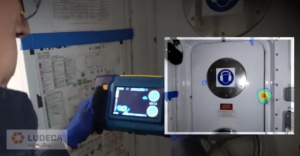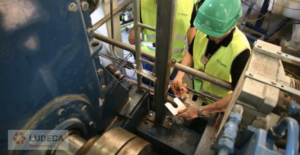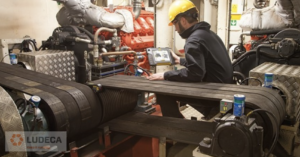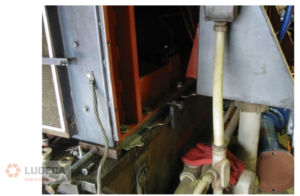Most every running asset – no matter the mechanism used when coupled together – can be subject to misalignment between driver and driven components. Proper alignment of belt-driven equipment is often neglected by maintenance and even reliability departments even though pulley misalignment is a principal reason for reduced belt life, premature sheave wear, and higher than necessary power consumption. Photo courtesy of JetTech Mechanical LLC HOW CAN BELT MISALIGNMENT AND ITS DAMAGING CONSEQUENCES BE PREVENTED? With today’s strict reliability requirements, the best method to utilize for belt alignment is a laser alignment instrument designed for this task. In addition to providing an extremely accurate, cost-effective, and time/labor decreasing process, there is the added bonus that some tools available on the market also offer a detailed report of the work performed,…
Precision Maintenance is one of the 15 foundational processes that is a must if you want to develop a complete maintenance system. Precision maintenance is the tasks that take place typically at commissioning or recommissioning to extend the life of an asset. Commissioning takes place at the initial startup of a newly installed asset or assets. Recommissioning is starting up an asset after it has been replaced or even worked on. The benefits of having a good series of Precision Maintenance Programs are a key to asset life extension, reduced energy consumption, reduced maintenance spend, and reduced unplanned downtime. Below are a few of the programs that should exist under the Precision Maintenance Process: Laser Alignment ProgramBalancing ProgramV-belt/Sheave Alignment ProgramBearing Installation ProgramTorquing and Fasteners ProgramDefined Measurements Program So, this begs…
The ability to perform inspections on sealed enclosures in order to identify areas that could leak under pressure or vacuum is easily accomplished by utilizing ultrasound. When a component’s tightness integrity deteriorates, one or two things can happen. Internal process fluids or gasses can leak into the environment, or contaminants can get into the process which can sometimes be catastrophic. Examples of this include: Inspection sealed storage tanks.Seals for vehicle around the passenger compartment.Identification of leaks in welded and fabricated tanks.Inspection of waterproof enclosures for equipment or switchgearShipping container and hatch inspections for the Marine cargo industry.Inspection of bulkhead seal areas on ships where electrical cables pass fromOne sealed compartment of a ship to sealed compartment. Watch our Tightness Testing with SonaVu Acoustic Imager video and learn how Ultrasound Imaging helps surveyors…
In general, laser shaft alignment systems have increased the ability to eliminate misalignment defects. There are many systems on the market, with varying capabilities, but the core benefit has been that the computer and laser work together to create an alignment report that can be used to assess and determine corrective action. With advances in the interface and measurement technology, the skill required to take measurements has been reduced when compared to older methods, such as dial indicators. Thus, more users can perform the job with less training for the task of gathering the measurements. Unfortunately, this convenience has in some cases resulted in the good practices of the fundamentals of shaft alignment falling by the wayside, given the perceived ease of use. It has gone so far that some systems have…
Shaft Alignment is a critical step in any world-class maintenance program, and when done properly, can help decrease unscheduled downtime and keep equipment running longer and more efficiently. This means machines need to be aligned within the recommended tolerances based on the RPM of the equipment. However, this is sometimes easier said than done, especially if any residual soft foot is present, or due to bad geometry in the movable piece of equipment. If you find yourself struggling to complete an alignment to tolerance, here are some tips that, when combined with Ludeca’s 5-Step Shaft Alignment Procedure, may help you complete the alignment faster and with less frustration. Get the position of the front feet close to the alignment offset tolerance. Once the front feet are close to or within the…
Saving short-term money at the cost of long-term loss could never be a good idea. Soft foot is one of the most prevalent problems in rotating machinery, and the improper use of shims is one of the bad guys. This is way too common and is the cause of countless machinery problems worldwide. But let’s not let that happen. Instead, let us guide you through the ideal shims procedure, for an easier alignment task. 1. INITIAL CHECK For safety, always remember lockout and tagout of the machine. Then you can go about inspecting the foundation, grout, and baseplate with your eyes. If there is rust, scale, paint, or dirt, remove all of this from under and around the feet. Then you replace damaged shims with new ones, that are corrosion…
OIL FILTER PERFORMANCE RATINGS You may have heard someone say, “a filter is a filter.” Although catchy, this phrase is very misleading. It is said assuming any filter will get the job done. Not all filters and lubricants are created equally. There is no one size fits all in this world of lubrication. Lubricants and filters must be selected based on the application. So why do we view oil as a consumable instead of an asset? Why do we see changing oil filters as a task that we complete off a schedule or perform filtration only when the oil lab says the oil is dirty? An oil filter to our oil is like a liver to our blood. With that understanding, we can appreciate the importance of proper filter selection…
Belt-driven rotating equipment is commonly found in all types of facilities. Typical applications include rolls, fans, motors, shafts, and blowers. It is important to maintain that equipment in order to increase its reliability. Maintenance is essential in today’s industrial environment to ensure assets and equipment are running as reliably as they should. Like any part that can wear over time, belt-driven equipment should be periodically inspected. This includes the inspection of the pulleys, sheaves, and belts. Worn belts and sheaves should be replaced. Belts should be properly tensioned and the equipment aligned. It is important to have quantitative values so that the condition of the machine can be evaluated and monitored over time. One way this can be accomplished is through ultrasound and vibration readings. Another value that can be…
When performing shaft alignment, the best way to accomplish the horizontal (side-to-side) corrections is using jack bolts. You do not want to hit your machines with a hammer in order to move them. Always remember to back off the jack bolts on the opposite side. Remember that once you are done with your side-to-side correction, we recommend that you always back off all jack bolts after the alignment is completed and the anchor bolts are tight. WHERE TO PUT THE JACK BOLTS ON YOUR MACHINE? Place the jack bolts in such a way that they do not interfere with the shimming and allow you to pivot the machine you are moving. See figures 1 and 2 below.
Belt driven machines are the Rodney Dangerfield of the maintenance industry – “they don’t get no respect!” For example, look at the image below. Belt driven machines do need a little bit more TLC than they currently get. I want to show you two innovations that will greatly improve your maintenance efforts on these highly efficient drives. I also want to show you why the general way in which we work with belt drives is a good example of what keeps reliability unachievable for many. First let me say that there are some individuals/organizations who really understand the value of doing this work right. I am reminded of a gentleman called Gary Burger who wrote a very good article on improving the efficiency of belt drives. He says that he…
Blog archive
- March 2024 (2)
- November 2023 (2)
- September 2023 (2)
- August 2023 (1)
- July 2023 (2)
- June 2023 (5)
- May 2023 (3)
- April 2023 (1)
- March 2023 (1)
- February 2023 (1)
Ludeca Blog
- The Battle Versus Single Axis or Triaxial Sensors!
- Case Study: Bore Alignment with Easy-Laser E950 on a Split-Casing Pump
- Why Lubricate?
- Shaft Alignment: What are the Setup Basics?
- Do you know what “Grease Worms” are?
- Three Myths About Greasing Bearings
- What Impact Does Precision Maintenance Have On Your Equipment?





